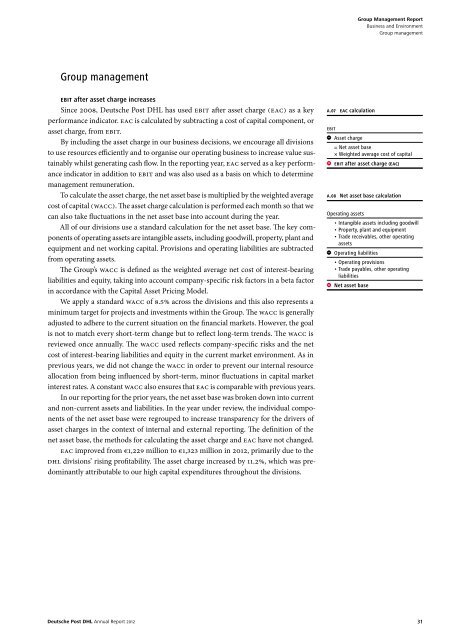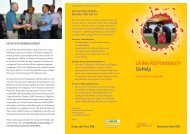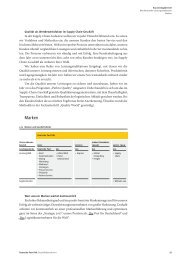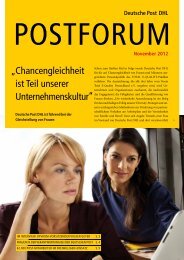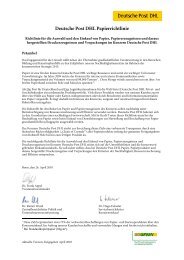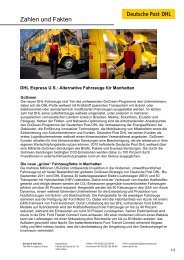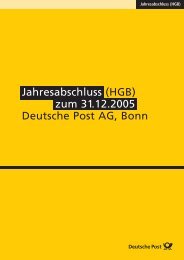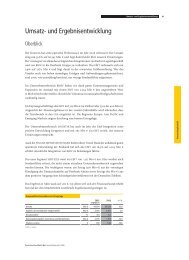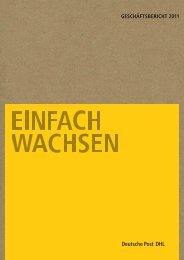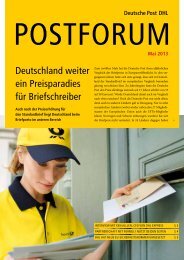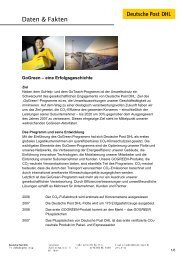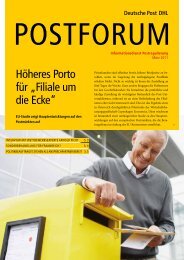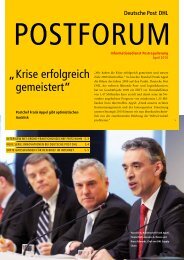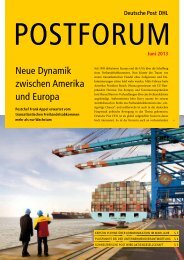Annual Report 2012 pdf (5 MB) - Deutsche Post DHL
Annual Report 2012 pdf (5 MB) - Deutsche Post DHL
Annual Report 2012 pdf (5 MB) - Deutsche Post DHL
You also want an ePaper? Increase the reach of your titles
YUMPU automatically turns print PDFs into web optimized ePapers that Google loves.
group management<br />
EBIT after asset charge increases<br />
Since 2008, <strong>Deutsche</strong> <strong>Post</strong> <strong>DHL</strong> has used EBIT after asset charge (EAC) as a key<br />
performance indicator. EAC is calculated by subtracting a cost of capital component, or<br />
asset charge, from EBIT.<br />
By including the asset charge in our business decisions, we encourage all divisions<br />
to use resources efficiently and to organise our operating business to increase value sustainably<br />
whilst generating cash flow. In the reporting year, EAC served as a key performance<br />
indicator in addition to EBIT and was also used as a basis on which to determine<br />
management remuneration.<br />
To calculate the asset charge, the net asset base is multiplied by the weighted average<br />
cost of capital (WACC). The asset charge calculation is performed each month so that we<br />
can also take fluctuations in the net asset base into account during the year.<br />
All of our divisions use a standard calculation for the net asset base. The key components<br />
of operating assets are intangible assets, including goodwill, property, plant and<br />
equipment and net working capital. Provisions and operating liabilities are subtracted<br />
from operating assets.<br />
The Group’s WACC is defined as the weighted average net cost of interest-bearing<br />
liabilities and equity, taking into account company-specific risk factors in a beta factor<br />
in accordance with the Capital Asset Pricing Model.<br />
We apply a standard WACC of 8.5 % across the divisions and this also represents a<br />
minimum target for projects and investments within the Group. The WACC is generally<br />
adjusted to adhere to the current situation on the financial markets. However, the goal<br />
is not to match every short-term change but to reflect long-term trends. The WACC is<br />
reviewed once annually. The WACC used reflects company-specific risks and the net<br />
cost of interest-bearing liabilities and equity in the current market environment. As in<br />
previous years, we did not change the WACC in order to prevent our internal resource<br />
allocation from being influenced by short-term, minor fluctuations in capital market<br />
interest rates. A constant WACC also ensures that EAC is comparable with previous years.<br />
In our reporting for the prior years, the net asset base was broken down into current<br />
and non-current assets and liabilities. In the year under review, the individual components<br />
of the net asset base were regrouped to increase transparency for the drivers of<br />
asset charges in the context of internal and external reporting. The definition of the<br />
net asset base, the methods for calculating the asset charge and EAC have not changed.<br />
EAC improved from €1,229 million to €1,323 million in <strong>2012</strong>, primarily due to the<br />
<strong>DHL</strong> divisions’ rising profitability. The asset charge increased by 11.2 %, which was predominantly<br />
attributable to our high capital expenditures throughout the divisions.<br />
<strong>Deutsche</strong> <strong>Post</strong> <strong>DHL</strong> <strong>Annual</strong> <strong>Report</strong> <strong>2012</strong><br />
A.07 EAC calculation<br />
EBIT<br />
asset charge<br />
= net asset base<br />
× Weighted average cost of capital<br />
EBIT after asset charge (EAC)<br />
A.08 Net asset base calculation<br />
operating assets<br />
• intangible assets including goodwill<br />
• Property, plant and equipment<br />
• trade receivables, other operating<br />
assets<br />
operating liabilities<br />
• operating provisions<br />
• trade payables, other operating<br />
liabilities<br />
Net asset base<br />
Group Management <strong>Report</strong><br />
Business and Environment<br />
Group management<br />
31


